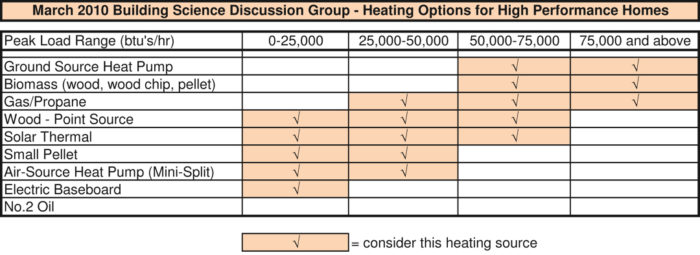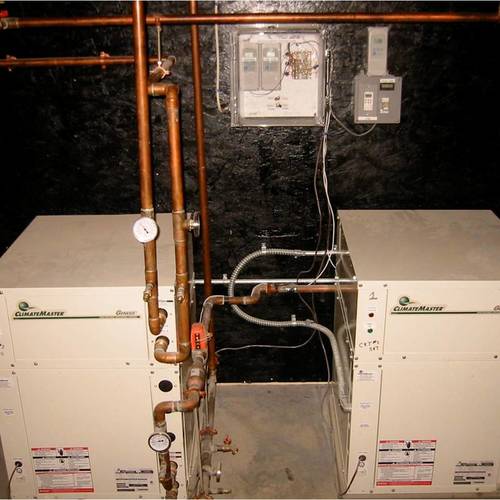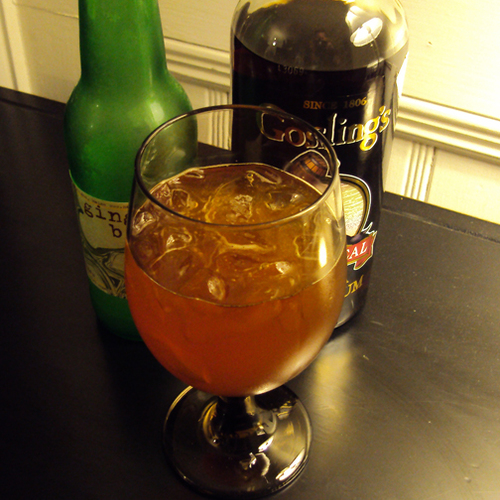Image Credit: Maine Green Building Supply, Portland, ME
Image Credit: Maine Green Building Supply, Portland, ME So how much do these systems cost? It depends on location and market conditions, but this information should help get you started. (Note the date of this posting when considering pricing)
Image Credit: Kaplan Thompson Architects This episode's cocktail: Bobby Burns Cocktail
*1 1/2 oz. Scotch Whiskey
*1 1/2 oz. Sweet Vermouth
*2 tsp. Benedictine
Stir with ice and strain into a chilled glass. Garnish with a lemon twist.
With any house, there are so many variables that influence the decision to choose one particular mechanical system over another: climate, house size, cost, local availability and cost of fuels and materials, and the lifestyle and preferences of the occupants. There is no “one-size-fits-all” system that we can reliably prescribe for all projects. Phil and I sat down over a good winter cocktail to share our views, anecdotes, battle scars, and wisdom on this important subject.
The Highlights:
The Bobby Burns Cocktail: “We’ll tak a cup o’ kindness yet for auld lang syne.”
Demand: Let demand be your guide. After climate, the peak load demand of your home is probably the most important thing to understand and define. (This means you’ll have to perform some energy modeling or at least a heat-loss calculation.) The chart developed by the Portland Building Science Discussion Group should help you identify the systems to consider.
Climate impact: Let your conscience be your guide. For some people, it’s not all about cost efficiency. It’s also about limiting emissions and the ecological footprint of the system itself. You may rule out oil and propane altogether.
Cost: Then, of course, there’s the cost of the system to consider. In the podcast, I mention the statistic that for most buildings (not just houses), the initial construction cost represents only 11% of the building’s total cost. I had a chance to chase down where the statistic is from: Solutions for Energy Security & Facility Management Challenges by the Association of Energy Engineers. (By the way, the calculation only considers operating costs for the first 40 years.)
That makes the efficiency of your system highly important. But the consideration of the initial cost is an inescapable reality. To help with this, we’ve provided a chart that shares some rule-of-thumb numbers for the systems mentioned. Of course, costs vary widely among different regions and installers. With time, this chart will become meaningless as the market changes.
Cost offsets: Remember, the goal here is to shrink the mechanical system in order to save money to offset the added cost of building a robust envelope.
GSHPs and radiant floors: Do they still make sense? Sometimes, maybe.
Six-digit idea: Let’s start importing (or better yet, manufacturing) the Magic Box here in the States.
Hot Zigg!: The Lunos e2 looks like a cool product that is approaching active ventilation in a whole new way. This is not an endorsement, as Phil and I haven’t used them yet, but something we’re keen to explore.
Phil’s pick: The song of the episode is “I’m Not Talking” by A.C. Newman. It’s a great album for the studio.
Don’t forget to register and attend Building Energy 13, a conference hosted by NESEA. Phil and I will be leading a Sprout Follies session in the Fundamentals Track on Thursday, March 7th at 2:00.
Thanks for listening. Cheers.
TRANSCRIPT
Chris: Hey, everybody, welcome to the Green Architects’ Lounge podcast. I’m your host, Chris Briley.
Phil: And I’m your host, Phil Kaplan.
Chris: We should start with an apology. Hey, everybody, sorry — we haven’t been recording much.
Phil: We’re going to pretend that people have been missing us?
Chris: Yeah. Sorry, folks. Today we’re doing how to choose a mechanical system. This is a conversation we have a lot with our clients. They want to know what the best one is for their house.
Phil: And there is a logical way to choose one. Chris and I have our systems — they’re not foolproof — but we’ve talked to some smart people and we’ll talk you through it.
[The guys jaw about Chris’s new partnership with Harry Hepburn, the possibility of having Bill McKibben on a future podcast, the NESEA conference, and this episode’s cocktail, the Bobby Burns.]
Phil: So how do we start choosing a mechanical system?
Chris: Let’s start with a chart. Imagine a building science discussion group filled with architects, raters, and builders. When asked to choose a mechanical system, each person chimes in with the best one. If you get anything from this podcast, it’s that there is no one solution.
Phil: Logic is only a small part of choosing a mechanical system.
Chris: “If that, then this” just doesn’t happen. So the building science discussion group decides to make this chart that shows when we consider the different systems based on the peak heating load — we’ve divided it up into 0 to 25,000 Btu, 25 to 50,000 Btu, 50 to 75,000 Btu, 75 to 100,000 Btu, and 100,000 and over — there are certain systems you look at, depending on peak heating load. Ductless minisplits for 0 to 25,000 Btu are a great choice. If it’s 75,000 or more, possibly you’d consider ground-source heat pumps. The chart has solar thermal, a woodstove for point-source heating — so you’d have to design for this one source of heat.
Phil: An open plan, compact.
Chris: And the downstairs communicates with the upstairs thermally. You’ve also got air-source heat pumps, which are fantastic for the lighter loads, and electric in general — electric boilers, baseboards — and of course, oil and gas boilers and furnaces.
I was talking to Marc Rosenbaum today, a mechanical engineer at South Mountain, and asked him how he chooses a mechanical system. Now that climate change has entered the conversation and has become a priority, let’s get away from fossil fuels. So, for Marc, it’s either electric or biomass. It’s a matter of heat load. If the heat load is rather high, 50,000 or more Btu, you’re looking at biomass. But some people may not want to schlep logs of wood to their wood boiler of woodstove, or they may not want to deal with pellets, which may not be available in their area. With lighter heating loads, you’re looking at electrical heat pumps — ground-source heat pumps or air-source heat pumps.
Phil: So, that’s it, we’re done! Cheers!
Chris: Well, with the ductless minisplits, it’s easy to take care of a lighter load house. Martin Holladay had a fantastic article in Fine Homebuilding.
Phil: Heating Options for a Small Home.
Chris: We recommend that everyone read that. It also covers the system in a passive house — UltimateAir has a combination unit.
Phil: A hot water coil off the ERV.
Chris: We’ve talked about a cold water coil for cooling. The thing is to trick the ERV into activating when there’s a demand for heating or cooling, not just fresh air.
Phil: We’re talking about a really low heating load: 10,000 Btu or even lower.
Marc has his ideas of what’s important, and so do we. Marc does not believe in sacrificing energy for looks. Aesthetics are important to architects in a different way than to engineers.
Chris: Clients are the same way. If they walk by a ductless minisplit cassette and think, “I hate that thing, the way it sits there on the wall and mocks me,” then it’s not worth it; it’s not going to work.
Phil: We all decide what’s most important for us.
Chris: Clients might just be looking at operation costs. They’re not trying to save the planet; they’re trying to save money. They’re trying to be the smartest kids on the block and have a really efficient house.
OK, Phil, let’s say a client comes to you and says, “I want a ground-source heat pump.”
Phil: Let’s go through the logical reasons about why we don’t use them. And the client says, “Yeah yeah yeah, but I still want one.”
Chris: And it’s not out of the question, but the conditions have to be right for that to be a smart choice. That does happen, but increasingly less.
Phil: We had another client who wanted electric baseboard. And it wasn’t a passive house. Close to it, but…
Chris: Just electric baseboard?
Phil: Just electric baseboard because they wanted a silent system. They were going to buy enough PV to offset it. But it wasn’t a great idea in terms of energy use.
Chris: I’ll share a battle scar. In the Redfern house — a little LEED Platinum house with 40 grand of hardware on the roof in PVs and solar thermal, and demand is really, really low — we cheaped out on an electric boiler. It’s a hot water heater, essentially, for the boiler. It really bothered me. Why at that last moment did we cheap out? I understand the economics. It’s really not going to be on that often. It’ll be offset by solar. But we could have put three more panels on to get to net-zero.
Phil: Remember, panels were a lot more expensive then — 8 or 9 grand per kilowatt. It’s less than half that now.
Chris: Well, we could have gone with one ductless minisplit and spent only a couple thousand more than with this electric boiler. And yeah, if you compared the two, would the minisplit ultimately have paid for itself based on how little it would be used? But the efficiency of it would have been worth it for the planet. To go that far and then cheap out… But the happy ending is there’s now a woodstove in the house and the boiler never comes on.
Phil: So one of the things that bothers you about a house is the climate damage, the CO2.
Chris: That’s a big part of the metric.
Phil: But for some people, number 1 is cost. That’s always a conversation.
Chris: That’s right. You did this passive house for $135 per square foot, and still people said, “My God, that’s expensive for a little house.” We’re competing with houses already on the market.
Phil: If we can reduce the cost of mechanical systems, we can put the extra dollars into the envelope. At 15,000 Btu, you can get yourself an HRV and a pre-heater. Eight to ten grand for that system; that’s pretty awesome. If the Btu go up to 25 to 30,000, can we stay below 10 grand?
Chris: That’s really hard. You need something in there to handle the load. A ductless minisplit.
Phil: Minisplits work even when it’s 0 degrees outside. If you’re real disciplined and have a tight, compact house, you could do it. It would be ductless and cost 9 to 12 grand. That’s assuming you have an electric resistance water heater.
Chris: What if I’ve got natural gas right out there on the street?
Phil: A combo hot water tank and air handler — a ducted system, but the gas is right there. Ten to 12 grand. When would you use a hot water heat pump? Probably around loads of 50,000 or more.
At fairly low loads, if aesthetics are important, you go to ducted minisplits. You’re adding a good 10 grand, maybe not that much. People spend a lot of money on pretty. Minisplits still stay off of fossil fuels, which is nice.
Chris: What if my house is way bigger?
Phil: Then you go to the gas boiler. It’s still not a bad system when you have a big house that’s an energy guzzler.
Chris: The gas boiler can be 94 to 98 percent efficient. And still cleaner than oil.
Phil: In the higher loads, wood pellet boilers make sense. Ground-source heat pumps.
Chris: They’re still there.
Phil: We didn’t talk about radiant.
Chris: The more robust the envelope gets, the more costly the radiant system — the hundreds of feet of tubing, the circulator pumps in every zone, the computer components to monitor things…
Phil: A complex system, locked in concrete.
Chris: You’re talking about a $25,000 system, depending on the load and the size of the house. You’re talking about buying a lot of hardware for radiant floors. And if your house is really well insulated and the demand is so low — let’s say 15,000 Btu — then you have a boiler pushing fluids through a slab…
Phil: They break all the time. And it’s rarely going to get the call.
Chris: If the computer component is smart enough, it’s tweaked the temperature to be in the comfort zone, which is below your body temperature.
Phil: And then it’s going to be cold underfoot.
Chris: Or not warm. You won’t even notice it’s on. But if you have a really leaky house, radiant might be a great system.
Phil: It comes down to what’s important to you. We advocate staying off fossil fuels, keeping loads down real low, keeping it simple.
Chris: We’re trying to get rid of this component.
Phil: The best mechanical contractors try really hard not to take your money.
OK, time for a 6-digit idea: the Magic Box. It’s a combination appliance with an HRV, a heat pump and a water heater. Zehnder makes them. But we can’t get them here yet.
Chris: What about the Lunos? They look like dryer vent type penetrations. It’s a way to handle the ERV without an ERV. It’s two holes in the building with ceramic filters in them. The filter is the temperature of the air. One opens up and breathes in. Then the other hole in the wall lets the breath out.
The better our buildings get, the more we need better and better technologies to run those better buildings.
[The episode closes with A.C. Newman’s song “I’m Not Talking.”]
Weekly Newsletter
Get building science and energy efficiency advice, plus special offers, in your inbox.














14 Comments
Promo code!
Hey folks. As presenters at the NESEA conference, we're able to offer a promo code to you! It gets you $100 off a 2-day pass (Wednesday, March 6th and Thursday, March 7th), or $50 off a 1-day pass (either Wednesday or Thursday).
The code is SPEAKERVIP
Lunos vs. Panasonic WhisperComfort
The Lunos is a beautiful design, but quite expensive compared to the Panasonic WhisperComfort.
The electrical efficiency is about the same.
Lunos would appear to distribute the fresh air much better, since the supply and exhaust are across the house from each other.
Panasonic has provided no test data yet to prove that it distributes fresh air just as well in an open floorplan. However, air molecules in a room bounce around at a velocity of about 500m/s. That means that fresh air distributes itself very quickly. (Obeying Fick's Law). Short circuiting should be nil in a large room, since the vanes on the grille direct the fresh air away from the stale air intake, and thermal differences create slight drafts that tend to mix the air.
Nice presentation of heatiing options...
But it would have been nicer yet had it paid at least lip service to cooling - at least a column with a cooling yes / no tick box
a little radiant - still might be in the mix
Good info above. A comment on radiant in small tight houses: It does not have to be: 1) in-slab; 2) throughout the house; and 3) expensive. I like using small amounts of low-temp, low-mass radiant (aluminum heat plates or whatever warmboard equivalent you like) in limited areas of the house where you really want the comfort of a warm floor: kitchen and eating area; maybe the bathroom, etc. It responds fast, is super comfortable, and can be designed to meet reduced heat loads of small tight homes at a reasonable cost...
a little radiant...
Todd-
You're absolutely right here. With a minimal distribution system, we often put a little radiant in the more remote corners, particularly the bathrooms, to supplement. We've found that radiant ceiling/wall panels in baths are slow to respond though, maybe these are better in the bedrooms.
Warm floors are nice but...
When I step out of a shower, the air temperature is more important to me than the floor temperature.
So a simple wall heater is anhttp://www.homedepot.com/p/t/203412328?catalogId=10053&langId=-1&storeId=10051&N=5yc1vZc4k3&R=203412328#.UTn7jdac5bp economical and effective choice :
Lip service to warm climates
Yes, we should have done more to combat our cold climate practices and offer more for air conditioning options and approach. I talked to Allison Bailes who plans ot chime in with some thoughts on the matter when he's done with his seminars on the road.
Chris
Pre heating for HRV
" At 15,000 Btu, you can get yourself an HRV and a pre-heater. Eight to ten grand for that system; that’s pretty awesome."
Can you fill me in on the particulars. We are planning a single ductless minisplit on a house we expect to require < 15,000 BTU with a Zehnder HRV with a preheat/cool groundsource loop added that improves efficiency and defrost issue but does not heat the house (not cheap at @9G total). What can be added to the HRV to replace the minisplit and heat the house using the HRV ducting? I did not think this was available....
Response to Phil Lawson
Phil,
I don't know about 15,000 Btuh -- but if you can get your design heat loss down to 8,700 Btuh, you can add a copper coil that circulates 160°F water to the supply air duct of your HRV. The necessary hardware is sold by Ultimate Air.
There are more details on this approach in an article I wrote for Fine Homebuilding, Heating Options for a Small Home.
Magic box and combined ventilation
Someone asked me to jump in here... I'm jason from UltimateAir. We have been 'piecing' systems together - this notion of ventilation and heat (cooling is another topic...). Yes, we can do some heating within the ventilation duct work. Limits being flow.. delivered air temp... efficiency? Please give me a shout for further discussions on what is being used. Plus- this year we plan on starting testing on a better combination- using an available small heat pump. Just getting into it now.. check with us over the next couple of months.
Response to Jason Morosko
Jason,
As long as you are visiting our site, you may want to comment on another page:
https://www.greenbuildingadvisor.com/community/forum/energy-efficiency-and-durability/27043/design-ground-loop-system-erv
Thanks.
Thanks for podcast
I took a module in commercial scale mechanical systems this year, building on stuff I have been doing progressively at Limerick IT over the past number of years - and boy did I eat off more than I could chew there. I'm studying for the examination right now, and finding all sorts of weird questions like: what are the three factors that affect the efficiency of a fan blade? Huh?
Anyhow, I submitted a final write up of a dissertation on Building Information Modelling in April, and one of the odd side affects of doing that dissertation, was to focus my attention on the subject of these mechanical systems that commercial scale structures seem to be about. If anyone cares to have a flick through, I've uploaded it to Scribd here:
http://www.scribd.com/doc/135072288/Decision-Making-and-Design-Cognition-in-the-age-of-Building-Information-Models
I had to try and force 'Don Draper' into the write up somehow, although, I'll admit that the connection between buildings and Mad Men is stretching it a bit far. Even for me. Regards, Brian O' Hanlon
Six-digit Magic Box
Would someone care to explain what the heck this is? I know because of the topic here, it has something to do with heating systems. Googling didn't help. I read the PDF, "Heating Opitions for a Small Home". Would a 1,500 square foot house qualify as small?
Response to Barbara A. Smith
Barbara,
Chris Briley and Phil Kaplan use the term "six-digit idea" to describe any idea they get after drinking a few cocktails that they think has the potential to earn someone a financial windfall -- a dollar amount of at least six digits.
Chris and Phil describe a "magic box" in the transcript on this page: it's "a combination appliance with an HRV, a heat pump and a water heater." For more information on magic boxes, see A ‘Magic Box’ For Your Passivhaus.
Q. "Would a 1,500 square foot house qualify as small?"
Q. It would be about average for a new home built in 1973. However, these days, the average new single-family home measures 2,392 square feet, so a 1,500-sq.-ft. home would be smaller than average.
Log in or create an account to post a comment.
Sign up Log in